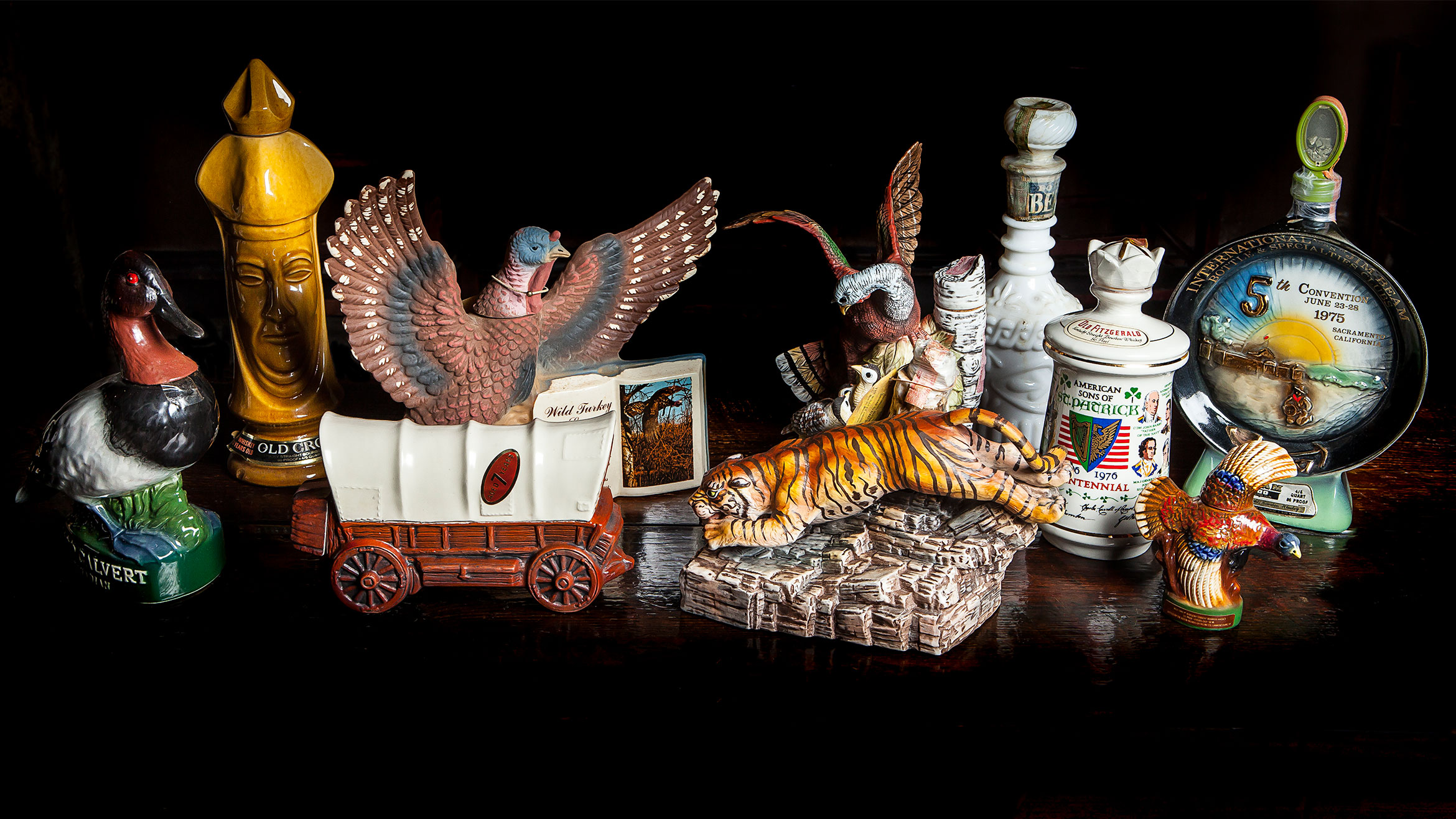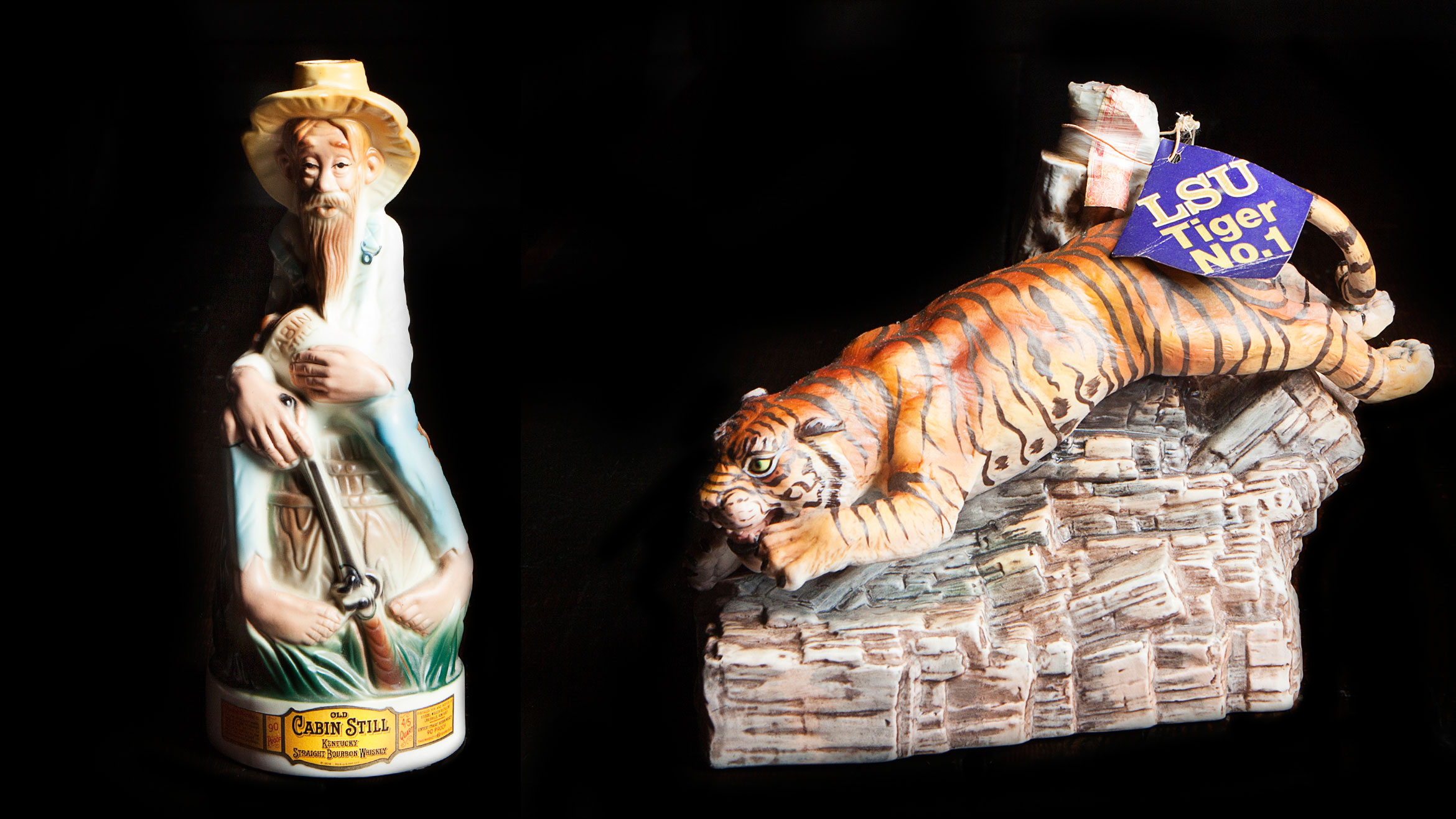Joshua Richholt has his doctor test him once a year for lead poisoning. Not because he’s been huffing paint or working out of an old office building, though. He simply insists on drinking bourbon from collectible, midcentury decanters, which, according to the FDA, have been found to leach lead into the liquid.
Richholt, a managing partner of Brooklyn’s The Well, is one of a small group of collectors (and drinkers) of these campy releases from a bygone era. “It was a way for us to get rid of old bourbon,” Fred Noe, master distiller of Jim Beam, says of these decanters, first produced by his company in 1953. “We just had so much inventory—150-months-old sometimes.”
When post-Prohibition Americans started drinking this new exotic spirit called vodka, Kentucky was soon left with a glut of well-aged bourbon. Jim Beam came up with a clever way to gussy up their lagging products: put standard Kentucky straight bourbon into decorative decanters made by the Regal China Company. The gambit worked. People scrambled to acquire these bourbon-filled keepsakes, shaped like everything from Corvettes to Poulan chainsaws to Elvis to disgraced former Vice President Spiro Agnew.
“In the ’60s and ’70s people collected the shit out of them,” Noe adds. “It was nuts.”
Other distilleries would follow suit. Starting in 1971, Wild Turkey released turkey decanters annually; Stitzel-Weller, the progenitor to Pappy, produced Rip Van Winkle versions; and Ezra Brooks made decanters in the shape of dueling pistols, potbelly stoves and the Iowa State Capitol.
Because of the potential lead concerns inherent in the ceramic, and a high propensity for evaporation due to bad closures, many modern whiskey enthusiasts have no interest in drinking the liquid. Thus, old “juice” that might typically fetch hundreds of dollars—if not thousands, in the case of Stitzel-Weller—can be purchased for dirt cheap at flea markets or yard sales.
“The thing was, all these collectors got old and died off, and no young people took up the hobby,” Noe explains. “So it went away. But there’s still a lot of good bottles around.”
Below, a few notable designs from Richholt’s extensive collection of nearly 100 vintage decanters. (And no, he doesn’t have lead poisoning.)
Jim Beam
Jim Beam released several dozen different decanters every year, for decades. These releases generated enough interest for the International Association of Jim Beam Bottle Collectors to be formed, with chapters in various cities across the globe. This typically garish decanter celebrates a 1975 convention put on by a Sacramento faction.
Wild Turkey
Wild Turkey is the most celebrated brand in the decanter game, due to both the quality of the artwork and the whiskey, which was usually 8-year-old bottled at the brand’s iconic 101 proof. Released in different series from 1971 through 1989, the liquid has the classic Turkey dusty “funk.”
Old Crow Chess Set (Queen)
The only decanter series that most modern geeks actively pursue, the one-time 1969 release offered 32 different pieces. This 10-year-old is considered by many to be some of the most exceptional liquid they’ve ever tasted. Unfortunately, bad closures means a potential buyer can only tell if a tax stamp-sealed bottle is full by weighing it. (Richholt claims it should be about four pounds.)
Old Fitzgerald Prime
A standard shape and style for the era, this “crockery” decanter was produced en masse and then painted with different honorees depending on the occasion. This 7-year-old Stitzel-Weller “wheater” celebrates South Carolina’s 1970 tricentennial. A mere two years later, the famed distillery would be sold to Norton-Simon.
Cabin Still Hillbilly
Stitzel-Weller began producing these 90-proof “hillbilly” bottlings as early 1954, eventually expanding into a full series of decanters featuring “fanciful characters from the Kentucky bluegrass where great bourbon was born,” according to the bottle’s neck. Even in 1969 when this model was released, the packaging materials were labeling it as a surefire collector’s item, “which will increase in value with the years.”
Old Bardstown LSU Tiger
Despite NCAA rules against alcohol branding, the Willett Distillery—using the name Old Bardstown—bottled a series of college mascot decanters in 1979. Though they produced ones for other teams like the Arkansas Razorbacks and Georgia Bulldogs, LSU decanters seem to appear most frequently on the secondary market and eBay.







